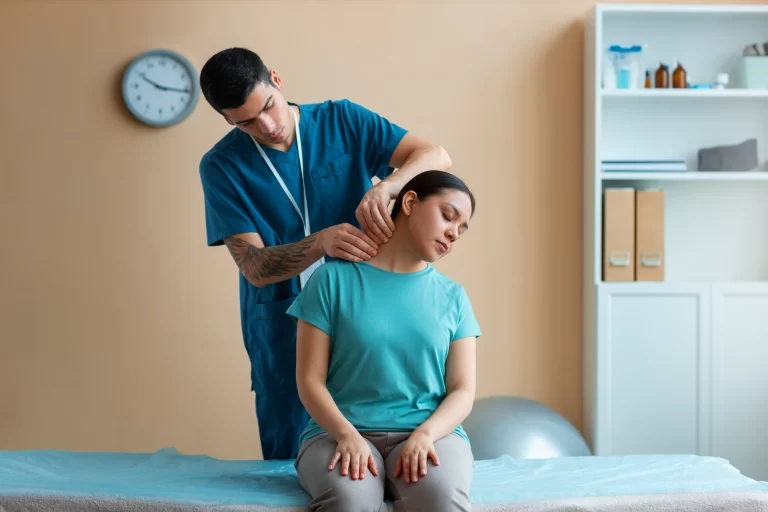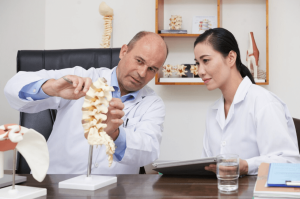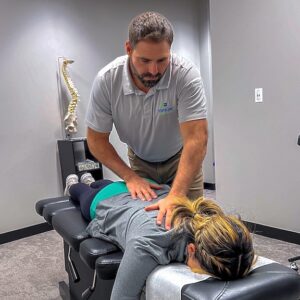Spinal stenosis, a condition characterized by the narrowing of the spinal canal, often leads to discomfort and limits mobility. While treatment options may vary, chiropractic care emerges as a non-invasive and effective solution for managing spinal stenosis. Let’s delve into the unique ways chiropractic care near me offers relief for this condition and why it’s becoming a preferred choice for individuals seeking non-surgical treatments.
Understanding Spinal Stenosis and Chiropractic Care
Understanding the Symptoms
Pain:
Individuals with spinal stenosis often experience pain, which can manifest as a dull ache in the affected area. This pain may radiate to other parts of the body, such as the legs or arms, depending on the location of the spinal narrowing.
Numbness or Tingling Sensations:
Numbness, tingling, or a feeling of pins and needles in the legs, arms, hands, or other affected areas are common symptoms. These sensations often occur due to the pressure on nerves caused by the narrowed spinal canal.
Weakness:
Spinal stenosis can lead to muscle weakness, reducing strength and coordination in the affected areas. Weakness in the legs or arms may impact mobility and daily activities.
Difficulty Walking:
Individuals with spinal stenosis may experience difficulties with walking or standing for extended periods due to pain, numbness, or weakness, affecting their ability to perform routine tasks.
Impact on Daily Life
Limitation in Physical Activities:
Spinal stenosis can restrict an individual’s ability to engage in physical activities or exercise due to pain and discomfort. This limitation can impact overall physical fitness and well-being.
Reduced Quality of Life:
Chronic pain and discomfort associated with spinal stenosis can significantly affect an individual’s quality of life, leading to frustration, anxiety, or depression.
Interference with Work and Social Life:
The symptoms of spinal stenosis may interfere with work-related tasks or social activities, impacting productivity and social interactions.
Varying Severity
Symptoms of spinal stenosis can vary in severity and may worsen over time. While some individuals may experience mild discomfort, others may have more pronounced symptoms that significantly impact daily life.
Importance of Timely Treatment
Recognizing and addressing symptoms early is crucial for managing spinal stenosis effectively. Seeking appropriate treatment, such as chiropractic care, can help alleviate discomfort and prevent the condition from progressing further.
Benefits of Chiropractic Care for Spinal Stenosis Relief
Comprehensive Assessment and Individualized Care
Chiropractors undertake a meticulous assessment process designed to gain a comprehensive understanding of a patient’s spinal stenosis. This assessment is multifaceted, encompassing various diagnostic tools such as spinal imaging, health history analysis, and physical evaluations. Spinal imaging, including X-rays or MRI scans, offers precise insights into the spinal structure, highlighting any abnormalities or signs of stenosis. Simultaneously, a comprehensive analysis of the patient’s health history provides essential contextual information regarding previous injuries, medical conditions, or lifestyle factors that may contribute to their spinal stenosis. Physical evaluations, including orthopedic and neurological assessments, help chiropractors gauge the extent of nerve compression and spinal misalignments.
This thorough assessment serves as the foundation for crafting personalized treatment plans tailored to address each patient’s specific needs. By pinpointing the unique conditions and symptoms related to the individual’s spinal stenosis, chiropractors can develop highly targeted and customized approaches to alleviate discomfort and promote spinal health. These personalized treatment plans may incorporate specific chiropractic adjustments, therapeutic exercises, lifestyle modifications, or ergonomic recommendations aimed at optimizing spinal alignment and reducing nerve compression. The individualized care ensures that patients receive treatment strategies precisely tailored to their condition, fostering effective and focused care for achieving relief from spinal stenosis symptoms.
Targeted Spinal Adjustments for Alleviating Pressure
Chiropractic care primarily revolves around spinal adjustments, aiming to correct misalignments and alleviate pressure on the nerves caused by spinal stenosis. These adjustments are precise, gentle, and focused on the affected areas. By realigning the spine, chiropractors seek to reduce nerve irritation and compression, thus mitigating the associated symptoms such as radiating pain, numbness, tingling, and weakness in the legs or back.
Alleviation of Nerve Compression and Pain Reduction
Spinal stenosis frequently leads to nerve compression within the spinal canal or openings between the vertebrae, resulting in a myriad of discomforts and constraints on mobility. This compression applies undue pressure on the spinal cord or nerve roots, triggering symptoms like localized pain, tingling sensations, numbness, and muscle weakness. Chiropractic care, particularly through targeted adjustments, focuses on alleviating this nerve compression. These gentle manipulations aim to restore proper spinal alignment, subsequently reducing the pressure exerted on the nerves. As the chiropractor works on realigning the spine, patients often experience a gradual easing of nerve compression. By addressing the root cause, these adjustments help mitigate discomfort and allow for enhanced nerve function, which contributes to the alleviation of pain-related symptoms associated with spinal stenosis.
As spinal alignment improves through chiropractic adjustments, patients commonly witness a notable decrease in discomfort. This reduction in discomfort is a pivotal aspect of chiropractic care for spinal stenosis. By relieving pressure on the nerves, patients often experience an enhanced quality of life due to improved functionality. As the spine is brought back into its proper alignment, the associated symptoms such as radiating pain, numbness, tingling, and weakness gradually diminish. Consequently, individuals with spinal stenosis may regain the ability to engage in daily activities with more ease and comfort. This improvement in functionality is often noted as a significant benefit of chiropractic care, as it directly correlates with the reduction in pain-related symptoms, enhancing mobility and overall well-being for individuals managing spinal stenosis.
Enhanced Blood Circulation for Healing
Proper spinal alignment facilitated by chiropractic adjustments may enhance blood circulation in the affected areas. Improved blood flow aids in delivering essential nutrients and oxygen to the spinal tissues, fostering healing and reducing inflammation. By promoting healing in the affected region, chiropractic care contributes to long-term pain relief and improved spinal health.
Improved Range of Motion and Flexibility
Spinal stenosis can restrict movement, leading to stiffness and reduced flexibility. Through chiropractic care, patients often observe an enhancement in their range of motion. As spinal alignment is corrected and nerve pressure decreases, individuals may experience increased flexibility, allowing for more comfortable movement and a greater ability to perform daily activities without discomfort.
Non-Invasive Approach as an Alternative to Surgery
Chiropractic care serves as a non-invasive alternative to surgical interventions for managing spinal stenosis. Through gentle and targeted adjustments, chiropractors aim to address the root cause of the condition without resorting to invasive procedures. By focusing on spinal realignment and nerve decompression, chiropractic care provides relief from spinal stenosis symptoms without the risks associated with surgery or lengthy recovery periods.
Long-Term Relief and Promotion of Overall Wellness
Chiropractic care emphasizes not only immediate symptom relief but also the promotion of long-term wellness. By maintaining spinal health and addressing underlying spinal issues, chiropractors aim to prevent the recurrence of spinal stenosis symptoms. Regular chiropractic sessions contribute to overall spinal health, leading to sustained relief and fostering a healthier lifestyle.
Patient Education and Lifestyle Recommendations
In addition to chiropractic adjustments, chiropractors often offer guidance on posture correction, ergonomic practices, exercises, and lifestyle modifications. These recommendations complement the treatments and empower patients to actively participate in their self-care. By educating patients on spinal health and offering tools for preventive measures, chiropractors empower individuals to take control of their spinal stenosis management beyond the treatment sessions.
Frequently Asked Questions
- What is spinal stenosis, and how does it affect the body?
Spinal stenosis refers to the narrowing of spaces within the spinal canal or vertebrae, which enclose and protect the spinal cord and nerve roots. This narrowing can exert pressure on these vital structures, resulting in various symptoms. Common symptoms include pain, tingling, numbness, and muscle weakness, typically in the lower back, legs, buttocks, or neck. These symptoms can limit mobility and affect daily activities due to nerve irritation and compression.
- How does chiropractic care help manage spinal stenosis?
Chiropractic care focuses on non-invasive techniques to address spinal issues. Chiropractors utilize spinal adjustments and manipulations to realign the spine, reduce nerve compression, and alleviate pressure on the affected nerves. By restoring proper spinal alignment, chiropractic care aims to relieve pain, reduce inflammation, and improve nerve function, thus aiding in the management of spinal stenosis symptoms.
- Is chiropractic care safe for managing spinal stenosis?
Chiropractic care is generally considered safe for managing spinal stenosis when administered by licensed and experienced chiropractors. These professionals undergo extensive training to perform adjustments safely and effectively. They use gentle techniques tailored to individual conditions, prioritizing patient comfort and safety. However, it’s essential to communicate any concerns or existing medical conditions with the chiropractor to ensure a suitable treatment plan.
- What are the primary benefits of choosing chiropractic care for spinal stenosis over surgery?
Opting for chiropractic care offers several advantages compared to surgery for managing spinal stenosis. Chiropractic adjustments provide a non-invasive approach that aims to address the root cause of symptoms. It avoids the risks and potential complications associated with surgical interventions, offering a conservative yet effective alternative. Additionally, chiropractic care often requires no downtime, enabling patients to resume their daily activities promptly.
- Can chiropractic care alleviate pain caused by spinal stenosis?
Yes, chiropractic adjustments are known to help alleviate pain associated with spinal stenosis. By realigning the spine, reducing nerve compression, and releasing pressure on the affected nerves, chiropractic care often results in decreased pain levels. This can lead to improved mobility, reduced discomfort, and enhanced overall quality of life for individuals with spinal stenosis.
- How long does it take to experience relief from spinal stenosis symptoms through chiropractic care?
The timeframe for experiencing relief from spinal stenosis symptoms can vary among individuals. Factors such as the severity of the condition, overall health, and response to treatment influence the relief timeline. Some patients may notice immediate improvements after the initial chiropractic session, while others may require several sessions or weeks of consistent care to observe significant relief from symptoms.
- Are there any risks or side effects associated with chiropractic care for spinal stenosis?
While rare, some individuals may experience mild soreness, discomfort, or temporary worsening of symptoms after chiropractic adjustments. These sensations typically resolve quickly and are considered normal reactions as the body adjusts to the realignment. Serious complications from chiropractic care for spinal stenosis are uncommon, especially when provided by skilled and qualified practitioners.
- How can I find a qualified chiropractor for spinal stenosis treatment near me?
To find a qualified chiropractor specializing in spinal stenosis treatment, consider utilizing online directories that list reputable practitioners in your area. Seeking referrals from primary healthcare providers, asking for recommendations from friends or family, or checking reviews and testimonials can also help identify chiropractors with expertise in managing spinal stenosis. Verify their credentials, experience, and specialization in spinal care before scheduling an appointment to ensure appropriate treatment.
Why Choose Us?
Discover unparalleled chiropractic care at Evolve Chiropractic of Gilberts, your destination for comprehensive wellness solutions. Our dedicated team is passionate about providing top-notch care focused on improving your spinal health and overall vitality. We go beyond traditional Chiropractic Services, offering a holistic approach that encompasses various facets of your well-being. Our personalized treatment plans include not only spinal alignment but also guidance on nutrition, tailored exercise routines, ergonomic improvements, and lifestyle adjustments. By addressing the root causes of discomfort and prioritizing your overall wellness, we aim to stand out as the best chiropractor near you. Come and experience the transformative difference at Evolve Chiropractic of Gilberts, where we’re dedicated to helping you evolve toward a healthier, more balanced life.
Evolve Chiropractic of Gilberts
219 E Higgins Rd, Gilberts, IL 60136, United States
847-649-3422





